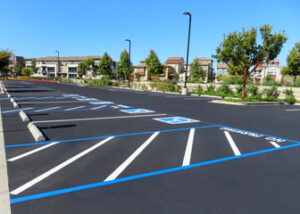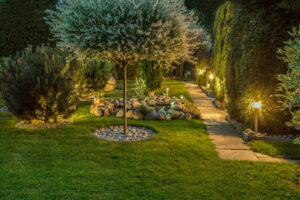Asphalt is comprised of rock and stone held together with a binder created by distillation from certain crude oils. Over time, UV rays, water and chemicals degrade this binder, causing the asphalt to discolor and become brittle.

Rochester NY Sealcoating re-establishes this protective layer, saving the surface from damage and ultimately extending its lifespan. This saves property owners money in the long run.
Asphalt pavement is constantly exposed to the elements, from bright sunlight that bakes oil out of the surface to cold winter snowstorms and thaw-freeze cycles that can cause cracking. Without regular maintenance, these factors can take a toll on the structure and integrity of the pavement, eventually leading to premature deterioration that necessitates costly repairs. A properly installed seal coat protects the pavement from these forces, extending its lifespan and enhancing its appearance.
The sealcoating process begins with thoroughly cleaning the entire asphalt surface to remove dirt, mud and oil spots. Linear cracks are blown out with air compressors and filled with a hot rubberized asphalt crack filler. The edges of the asphalt are then trimmed and edged with a strip of black rubber to ensure an attractive finished look. Next, the surface is broomed with power brooms to further remove dirt and mud from the asphalt. Any oil and stains will be treated with a primer to help the sealcoat adhere. The tack coat is then applied to the surface, which acts like a glue to bind the new sealcoat to the asphalt.
After the tack coat has cured, workers can then apply two thin coats of asphalt sealer to the surface, each approximately one-eighth inch thick. This allows for the greatest amount of protection with the least amount of material used, maximizing your budget and ensuring that all areas are covered. The final step is hand squeegeeing all edges to provide clean, straight lines and to add extra sealer where needed. Traffic is allowed back on the surface as soon as the work is complete.
In addition to protecting your asphalt from the elements, a proper seal coat will also protect the surrounding landscaping and structures from damage. The chemicals in coal tar and asphalt emulsions are dangerous to any vegetation that comes into contact with them, and repeated exposure can even cause health problems for people working outside. Seal coating with a polymer-modified asphalt emulsion significantly reduces these hazards, making it a much safer option for your driveway or parking lot.
Increases Lifespan
Sealcoating is an affordable way to protect your property’s paved surfaces. When properly applied and resealed in regular intervals, it significantly extends the life of asphalt pavement, deferring costly repairs and replacing expenses into the future.
Without sealcoating, asphalt is exposed to the elements including UV rays, rain, and chemical penetration that wear away at the surface, causing it to become brittle and susceptible to cracking. The oil content in asphalt makes it flexible; however, over time, these oils break down and reduce its flexibility. Sealcoating is an effective solution that provides a protective shield that halts the degradation process and keeps the asphalt surface looking newer longer.
A few factors influence the longevity of a sealcoat, including the quality of the product used and the application method. A high-quality sealant, when properly applied by an experienced professional, can last up to 5 years or more. Traffic volume and frequency also impacts the lifespan of a sealcoat; heavily used surfaces may require resealing at more frequent intervals than low-traffic areas.
Proper maintenance practices such as cleaning the pavement regularly, addressing cracks promptly, avoiding heavy loads, and scheduling regular resealing will increase the lifespan of the product. In addition, ensuring that proper drainage is practiced will help the pavement maintain its moisture levels. Lastly, using additives in the sealant mix can also improve its performance and lifespan. These additives serve a variety of purposes including drying the sealcoat faster, altering the sand suspension, strengthening the cured film, increasing water repellency, and enhancing color.
The lifespan of a sealcoat is further increased by scheduling resealing before visual indicators of wear and tear appear on the surface. These indicators are easy to spot and often include fading, cracks, or loss of smoothness. Regular inspections and maintenance will allow you to catch these signs before they become serious problems that require costly repairs.
Taking the steps to safeguard your investment in commercial lots and driveways with regular sealcoating is an economical, long-term solution that will prevent costly repairs and replacement expenses over the years. Contact us today to learn more about our expert sealcoating services and maintenance programs that can optimize the longevity of your asphalt.
Enhances Appearance
Whether you operate a business or own a residential property, your parking lot plays a key role in how people perceive your entire building or estate. A well-maintained, attractive asphalt surface not only increases curb appeal, but it shows you care about your property and take pride in your work.
Seal coating fills in hairline cracks and minor pits to keep water, chemicals, heat, and oil from penetrating the surface of the pavement and damaging it over time. It also enhances the appearance of your paved surface by bringing out its natural, rich black color and minimizing oil drips and spots.
In addition to protecting the surface from weathering and damage, a sealcoat helps prevent the pavement from oxidation. This happens when the petroleum binder in asphalt starts to break down over time due to sun exposure and moisture. The process slows down once a sealcoat is applied, as it blocks the oil from reaching the base material and causing it to deteriorate.
Before sealcoating can begin, the paved area must be power washed and completely dry to ensure that no oils are left behind that would cause the finish to peel or flake. Additionally, the cracks should be filled with an asphalt crack filler before sealing the area.
The type of sealant used for the job is a crucial factor in determining how long the application lasts. Choosing a high-quality, refined coal tar emulsion will produce the best results in terms of longevity. While some have expressed concern that refined coal tar products pose health risks, generations of family-owned sealcoat companies have experienced no significant issues related to working with this substance.
The bottom line is that a sealcoat protects the asphalt from environmental damage and extends its lifespan. It’s a cost-effective and practical way to minimize the need for major repairs and maintain a beautiful, clean appearance for your paved surface. If you’re interested in having your Harrisburg or York property’s paved surfaces professionally sealed, contact us for a free estimate and quote. We look forward to serving you! -Paterson Paving & Sealcoating.
Reduces Maintenance
A fresh coat of sealant on a parking lot or asphalt surface can improve the curb appeal of any commercial, industrial or residential property. It creates a positive first impression for customers, tenants and residents. The unified look also sends a message that the owner cares about the property and takes pride in maintaining it.
Considering the cost of repair and replacement of damaged asphalt surfaces, sealcoating is a very economical maintenance option. Unlike the costly alternative of complete removal and resurfacing, sealcoating repairs cracks and fills minor damage before they become larger problems that require more extensive repair.
Pavement damage increases the risk of accidents and injuries to pedestrians and vehicles. Uneven and cracked surfaces are difficult to decipher for drivers and increase the likelihood of vehicle damage. Sealcoating helps to prevent these occurrences and reduce the potential of expensive lawsuits from accidents on your property.
Most sealer is made up of a liquid asphalt binder, such as refined coal tar, along with aggregate (usually silica sand or Black Beauty boiler slag) and additives. The binder binds the aggregate to prevent oxidation and promote longevity. The additives – such as anti-oxidation agents, UV inhibitors and water repellents – enhance the performance of the pavement by providing additional protection from the elements.
By filling in hairline cracks, which are an early sign of asphalt aging, sealcoating prevents moisture from penetrating the pavement and causing further damage. The sealer also dries quickly, often within 24 hours. The drying process is accelerated by warm temperatures and sunlight. Once it dries, traffic can move freely over the treated surface.
When applied by a professional, a high-quality sealant should last for two to three years. To ensure that the coating will last, it is important to select a reputable contractor and to schedule the work at an appropriate time. In order for the sealant to bond effectively with the asphalt, the climate conditions must be just right – it can’t be too hot or cold, and it can’t rain before or after application. Before applying the sealer, workers should power wash the area to remove any dirt and chemicals. Then they should sweep the surface to remove loose gravel and debris. During the application process, workers should close off the area to vehicular traffic using cones and barricades and provide safe areas for pedestrians with warning tape.
